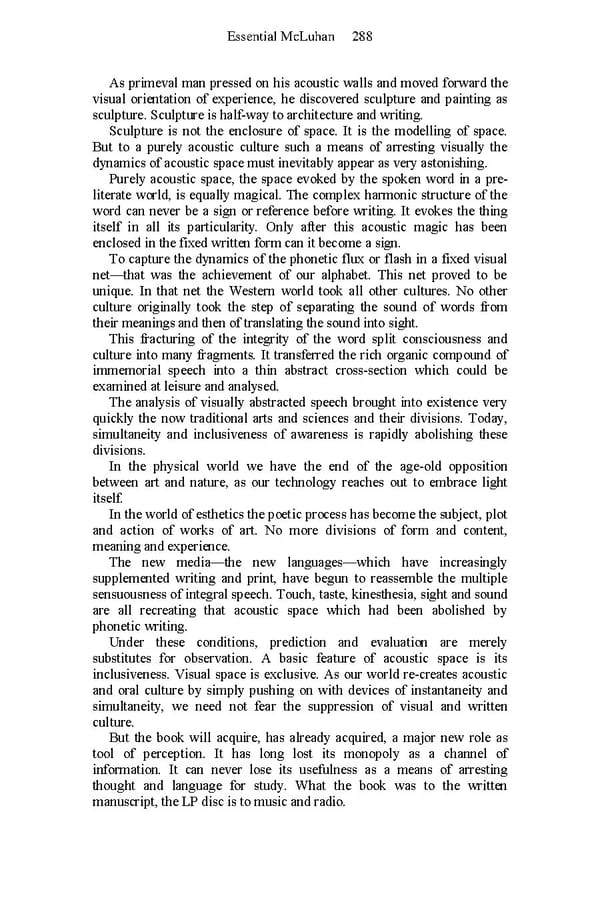Essential McLuhan 288 As primeval man pressed on his acoustic walls and moved forward the visual orientation of experience, he discovered sculpture and painting as sculpture. Sculpture is half-way to architecture and writing. Sculpture is not the enclosure of space. It is the modelling of space. But to a purely acoustic culture such a means of arresting visually the dynamics of acoustic space must inevitably appear as very astonishing. Purely acoustic space, the space evoked by the spoken word in a pre- literate world, is equally magical. The complex harmonic structure of the word can never be a sign or reference before writing. It evokes the thing itself in all its particularity. Only after this acoustic magic has been enclosed in the fixed written form can it become a sign. To capture the dynamics of the phonetic flux or flash in a fixed visual net—that was the achievement of our alphabet. This net proved to be unique. In that net the Western world took all other cultures. No other culture originally took the step of separating the sound of words from their meanings and then of translating the sound into sight. This fracturing of the integrity of the word split consciousness and culture into many fragments. It transferred the rich organic compound of immemorial speech into a thin abstract cross-section which could be examined at leisure and analysed. The analysis of visually abstracted speech brought into existence very quickly the now traditional arts and sciences and their divisions. Today, simultaneity and inclusiveness of awareness is rapidly abolishing these divisions. In the physical world we have the end of the age-old opposition between art and nature, as our technology reaches out to embrace light itself. In the world of esthetics the poetic process has become the subject, plot and action of works of art. No more divisions of form and content, meaning and experience. The new media—the new languages—which have increasingly supplemented writing and print, have begun to reassemble the multiple sensuousness of integral speech. Touch, taste, kinesthesia, sight and sound are all recreating that acoustic space which had been abolished by phonetic writing. Under these conditions, prediction and evaluation are merely substitutes for observation. A basic feature of acoustic space is its inclusiveness. Visual space is exclusive. As our world re-creates acoustic and oral culture by simply pushing on with devices of instantaneity and simultaneity, we need not fear the suppression of visual and written culture. But the book will acquire, has already acquired, a major new role as tool of perception. It has long lost its monopoly as a channel of information. It can never lose its usefulness as a means of arresting thought and language for study. What the book was to the written manuscript, the LP disc is to music and radio.
 Essential McLuhan Page 294 Page 296
Essential McLuhan Page 294 Page 296